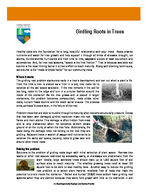Girdling Roots in Trees
Healthy roots are the foundation for a long, beautiful relationship with your trees. Roots provide nutrients and water for tree growth and help support it through all kinds of stresses: drought, ice storms, thunderstorms, hurricanes and from time to time, wayward pieces of lawn equipment and automobiles. And, for tree root systems, "space is the final frontier." That is because available soil volume is the most limiting factor in a tree's effort to reach maturity. Along with planting techniques, soil volume is the "make or break factor" for our community trees.
Where it starts The girdling root problem starts very early in a tree's development and can cut short a plant's life. From the time a tree is placed as a liner in a pot, tree roots try to colonize all the soil space available. If the tree remains in the pot for too long, roots hit the edge and turn in a circular fashion around the inside of the container. As the tree grows and is placed in larger containers, the problem becomes compounded; roots choke other roots, nutrient flows decline and the death spiral ensues. The process ends, perhaps 10 years later, in the failure of the tree.
Problem trees that are able to muddle through to maturity often become structurally unsound. Decay that has taken over damaged, girdled roots can move into root flares and main stems. This damage is often hidden from view and is only discovered when rot becomes evident above ground or on the trunk, or when the tree fails. Additionally, the roots doing the damage need not belong to the tree they are girdling. Adjacent trees in search of oxygen and nutrients try to colonize the same soil space, causing roots to grow over and around other trees' roots
Solving the problem Solutions to the problem of girding roots begin with initial selection of plant space. Narrow tree lawns or other root spaces restricted by sidewalks, walls, or driveways are problematic from the
start. Ideally, large overstory trees should have up to 1,000 square feet of soil surface area to reach maturity. The smallest growing trees need at least 100 square feet to be able to lead healthy lives. Another way to reduce the girdling root problem is to select plant material relatively free of roots that have the potential to circle inside the container. "Balled and burlap" (B&B) trees seldom have girdling root systems when they are planted because they were field grown with little or no restriction in soil
An Equal Opportunity Employer and Service Provider
volumes. When the trees are dug from the nursery, much of the root system is removed for ease of shipping, and with proper planting the tree starts regenerating lost roots. Containerized trees have a much different challenge. If the tree can't be removed from the pot for inspection prior to purchase, it is critical to cut any girdling roots before planting. Some of these roots can be "un-circled" from around the stem and straightened out as the tree is placed in the ground. This will greatly reduce the chance of girdling roots becoming a problem years later.
When girdling roots are discovered on existing trees, it is important to determine what long term effect they will have on the tree. A certified arborist should be consulted about the long term impact of the root growth and advise treatment. Most often the root should be removed by cutting it away in a manner that minimizes damage to other roots or the trunk. Sometimes the girdling root will have to be cut away before the full extent of the damage can be revealed. Should the impact of the girdling roots be extensive, the arborist may recommend removal of the tree and suggest a more appropriate replacement.
Girdling roots are not new to nature nor are they specific to urban sites. Awareness of the causes and hazards of the problem will help your trees live long, healthy lives in your landscape.
